TL;DR
Most paver patios cost $18–45 per sq. ft. installed in 2025, while DIY materials often land at $8–16 per sq. ft.; small modular retaining walls run $60–120 per linear foot installed, or $20–45 in materials. Use this guide to estimate, compare DIY vs contractor pricing, and plan how to manage excavation, drainage, and long-term maintenance.
Introduction

Proper layering and leveling are key to a durable paver patio foundation.
Hardscaping Costs in 2025: What a Paver Patio and Retaining Wall Really Take to Build
Most paver patios need 6–8 inches of compacted base, 1 inch of bedding sand, and 2–3 inches of paver thickness for a durable install.
Homeowners keep asking what a hardscape “should” cost, and the honest answer is, it depends on soil, access, design, and who is doing the work. I’ve walked yards where a compact 300-square-foot patio penciled out at a weekend’s worth of DIY and a few thousand in materials. I’ve also met families who paid professional crews fairly to transform grade, manage drainage, and deliver a laser-flat surface that lasts decades.
Here’s why that matters: hardscaping isn’t just stone. It’s excavation, haul-off, gravel, drainage, edging, compaction, and the kind of detail that keeps frost and storms from wrecking your weekend. Think of it as building an outdoor floor with its own foundation.
Field note: in central New Jersey, a homeowner completed a 20×24-foot paver patio with a 48-foot modular retaining wall, daylighted gutter drains, and backyard power runs for a materials total just over five thousand dollars across two seasons. That number sits squarely inside typical DIY ranges for the scope.
What Drives Hardscaping Cost
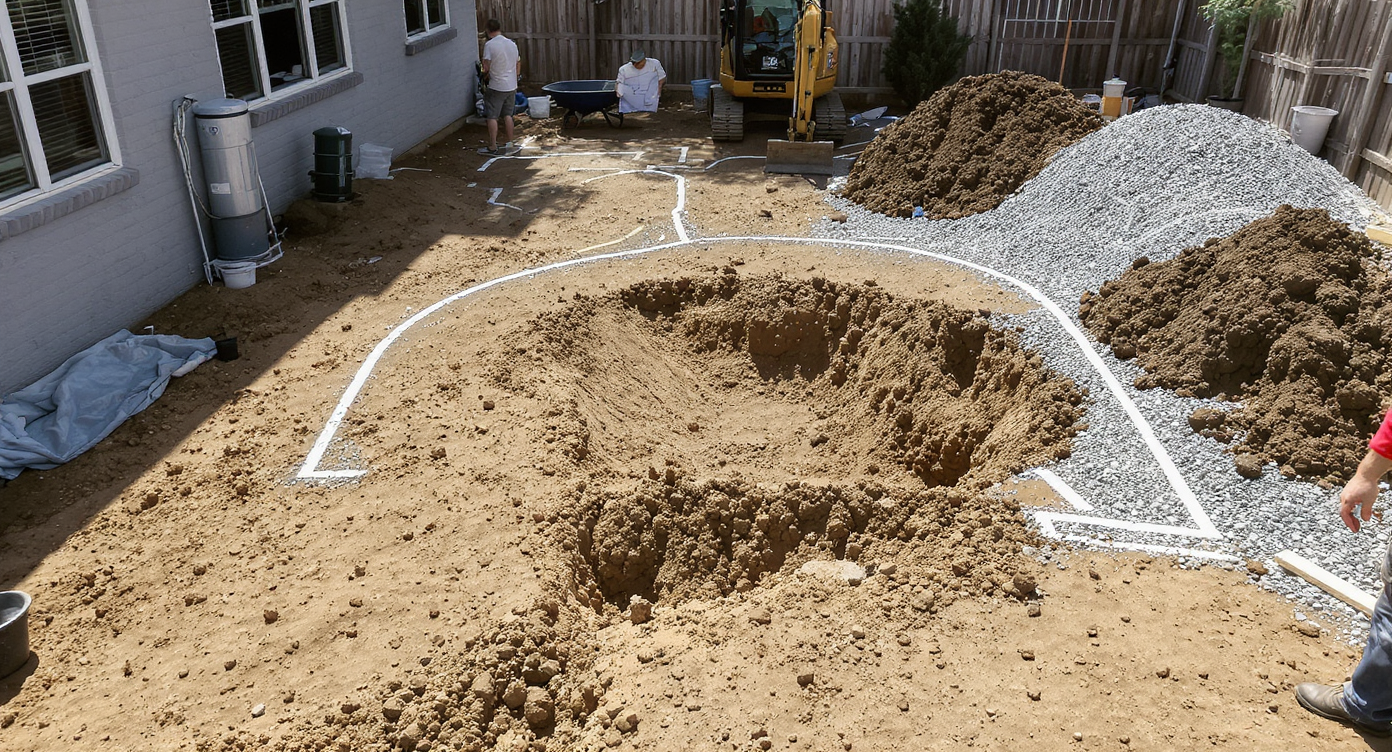
Site condition, materials, and labor complexity drive the total cost of your hardscape project.
Theme Overview: What Drives Hardscaping Cost
Most hardscaping budgets are set by square footage, wall length, soil conditions, site access, and labor approach (DIY vs contractor).
From paver patios to small retaining walls, the big levers are base depth, material quality, and how much earth you need to move. Designers often cite these core ranges: paver patios at $18–45 per square foot installed (DIY materials $8–16), small modular retaining walls at $60–120 per linear foot installed (DIY materials $20–45). Add native landscaping, a clean pathway, and a fire pit and you’ve essentially planned a backyard design that blends utility and curb appeal. Short-tail keywords you’ll keep seeing: hardscaping cost, paver patio cost, retaining wall cost, backyard design, native landscaping.
Anecdote
In a New Jersey backyard, a two-season DIY built a 20×24 patio and a 48-foot wall for just over $5,500 in materials, including drains to daylight and underground power—proof that patience and planning can stretch a budget without skimping on standards.
10 Ideas, Tips, and Designs for Planning Your Hardscape Budget

Collaborative planning with professionals helps optimize your hardscape budget and design.
01. The Honest Budget Formula
Most paver patios price out by the square foot and retaining walls by the linear foot and wall height.
What it is: A simple rule-of-thumb to estimate hardscaping costs fast, useful for container gardening corners to full backyard patios.
How it works: Multiply patio area by an installed range of $18–45 per sq. ft., or DIY materials at $8–16 per sq. ft. For a 480-sq.-ft. patio, that’s $8,600–$21,600 installed or roughly $3,800–$7,700 in materials. For small modular retaining walls (2–3 feet tall), use $60–120 per linear foot installed or $20–45 for materials. Add 10–20% for curves, steps, difficult access, or premium pavers. Professionals note that tight lots, clay soils, and long wheelbarrow hauls can push labor to the high end.
- Sketch the patio and wall lengths, then run both DIY and installed math.
- Use a mid-range paver and modular wall block to keep the look timeless.
- Plan a 10% contingency; hardscape projects often reveal hidden grade issues.
02. DIY vs Pro: Where the Line Lives
Walls over 3–4 feet usually require engineering, permits, and a drainage plan, which often favors hiring a contractor.
What it is: A safety and quality decision point for backyard design and long-term performance.
How it works: DIY shines for patios on simple grades, short garden walls, and straightforward access. A pro is wise when you see slope corrections, deep excavation, multiple steps, or tight timelines. Horticulturists and contractors alike stress compaction: expect 3–5 passes per lift of base gravel with a plate compactor. If the wall exceeds local height limits or supports a driveway/slope, bring in an engineer.
- Call 811 before digging, and verify setbacks and wall height rules.
- Rent a compactor; it’s the cheapest insurance you’ll buy.
- If you DIY, keep walls under 3 feet and add proper drain tile and fabric.
03. The Paver Patio Blueprint
A 20×24-foot patio often requires about 14 cubic yards of excavation if digging 9–10 inches for base, bedding, and pavers.
What it is: A proven build sequence for durable paver patios in sun or part shade.
How it works: Strip sod, excavate to depth, and install woven fabric over stable subgrade. Add 4–8 inches of compacted base in 2-inch lifts, then 1 inch of screeded bedding sand. Set pavers, cut edges, install edging, and sweep in polymeric sand. Field note: in central New Jersey, a homeowner’s two-season build that included a 20×24 patio, a 48-foot wall, gutter drains to daylight, and underground power landed near $5,500 in materials, squarely within DIY expectations for that scope and region.
- Order 5–10% extra pavers for cuts and future repairs.
- Choose steel edging over plastic for a crisper, longer-lived edge.
- Compact pavers after sand fill to lock joints before the first storm.
04. Retaining Wall Reality Check
Most modular walls need a 6–8-degree batter, a level base course, and a perforated drain behind the first course.
What it is: The structural side of hardscaping, holding grade while looking effortless.
How it works: Excavate for a base trench (often 6–8 inches below grade), add compacted base, and set the first course dead level. Stack with setback (batter) per block specs, backfill with clean stone, and wrap soil transitions with fabric to prevent fines migration. Expect $20–45 per linear foot in DIY materials for low walls, $60–120 installed, with steps, curves, and cap upgrades nudging higher.
- Use clean 3/4-inch stone for backfill to speed drainage.
- Place the perforated pipe holes-down and daylight it.
- Glue caps on a clean, dry day for a neat finish line.
05. The Hidden Costs: Dirt, Rock, and Access
Haul-off for excavated soil often runs $30–70 per cubic yard or $200–600 per small dump-truck load, depending on locality.
What it is: The part of the budget many homeowners underestimate.
How it works: A 480-sq.-ft. patio dug 9–10 inches deep can generate 13–15 cubic yards of spoil. If your municipality limits soil dumping or transfer stations refuse mixed dirt, plan for trucking. Delivery fees for gravel and pavers, rental of a compactor, and potential sod disposal add up. I’ve seen gardeners in dense neighborhoods stash clean fill for neighbors who need it, reducing haul-off costs and timelines.
- Ask suppliers about split deliveries to match your project phases.
- Budget rentals: plate compactor, masonry saw, and wheelbarrows.
- Stage materials near the site to cut labor and chaos.
06. Drainage Is a Design Feature
Every patio needs positive pitch—at least 1/8–1/4 inch per foot—away from structures to move water.
What it is: Quiet insurance that protects pavers, foundations, and plantings.
How it works: Tie downspouts to solid pipe and daylight them well beyond the patio. Behind retaining walls, use clean stone and perforated pipe wrapped in fabric. Where rain gardens make sense, direct overflow to a planted basin of natives like switchgrass and blue flag iris. Experts recommend maintaining uninterrupted slopes so puddles do not undermine bedding sand.
- Set a string line to confirm pitch before setting pavers.
- Add a catch basin where grade forces water to collect.
- Protect outlets with riprap to stop erosion.
07. Regional Reality Check
Installed patio pricing tends to be lowest in parts of the Midwest and highest in coastal metros and California.
What it is: A practical look at geography’s impact on hardscaping cost.
How it works: In many Midwest markets, installed paver patios often run $18–35 per sq. ft., while Northeast and Pacific Northwest markets frequently sit $22–45. California coastal quotes can exceed $45 where labor, permits, and access are complex. Retaining walls track similarly, with higher rates in urban areas and on steep lots. Factor your USDA zone and frost depth into base decisions, since freeze-thaw cycles demand deeper prep.
- Ask three local contractors for written, apples-to-apples bids.
- Request line items for base, drainage, edge, and disposal.
- Time your project for shoulder seasons to improve scheduling.
08. Materials That Age Well
Polymeric sand, steel edging, and mid-tone pavers typically reduce maintenance and hide everyday wear.
What it is: A low-maintenance palette for eco-friendly yards and small patios.
How it works: Mid-grays and warm tans mask dust and pollen; polymeric sand helps deter weeds and ants; steel edging holds straighter over time than plastic. If you prefer decorative gravel, use larger chips (3/4 inch) with a firm border to minimize scatter. Horticulturists note that keeping joints and edges tight is half the battle against weeds.
- Choose pavers with textured faces to improve traction.
- Use a compacted gravel path in low-traffic zones to save budget.
- Seal high-traffic areas if you want deeper color and easier clean-up.
09. Plan Power and Lighting Early
Running conduit beneath the patio base before you set pavers avoids future tear-outs and change orders.
What it is: A foresight step that elevates outdoor rooms with safe, flexible power.
How it works: Lay schedule-40 PVC in the base layer to future-proof for path lights, heaters, or an outdoor kitchen. For string lights, many homeowners set metal posts in-ground or anchor posts inside large planters filled with concrete. Keep connections GFCI-protected and weather-rated.
- Map outlets to furniture zones and the grill.
- Use low-voltage LED path lights for soft, efficient glow.
- Label conduits with pull strings for easy upgrades.
10. Permits, Codes, and Peace of Mind
Many jurisdictions require permits or engineering for retaining walls over 4 feet and for new electrical runs outdoors.
What it is: The compliance layer that keeps projects safe, insurable, and sale-ready.
How it works: Check local frost depth, setbacks, and drainage rules; call 811 before digging; confirm handrail requirements if you build steps. Insurance-minded homeowners prefer licensed, bonded, and insured contractors when hiring. Keep all receipts and photos; they help with future resale and warranty claims.
- Print manufacturer specs for your wall and follow them closely.
- Photograph each layer: base, drain, fabric, and backfill.
- Store extra pavers and caps for future touch-ups.
Bringing It Together

Expert craftsmanship blends structure and landscape for lasting outdoor spaces.
Transitional Reflection
Every durable hardscape is part architecture, part earthwork, and part patience.
The beauty of modern backyard design isn’t perfection, it’s participation. When stone meets soil with care, you get a patio that feels inevitable, a wall that quiets the slope, and weekends that stretch a little longer around the fire.
Visualize Before You Build

Visualizing your hardscape design in advance saves time, money, and surprises during build.
How to Visualize It
Seeing a layout before you dig can save thousands in changes and weeks of rework.
Before you plant or place a single paver, map your space virtually. Platforms like ReimagineHome let you preview garden layouts, sun paths, color palettes, and hardscape edges—turning sketches into living blueprints you can share with a contractor or tackle DIY with confidence.
Visualization Scenario
A narrow lot steps down from a back door to a sloped lawn. You test a 16×20 rectangle vs a 20×24 L-shape, previewing where string lights anchor, how the grill clears the door swing, and where a two-step transition meets a low wall and native pollinator border—then swap paver colors until the furniture layout and pathways click.
FAQ
How much does a 20×24 paver patio cost in 2025?
Installed costs commonly range $8,600–$21,600 at $18–45 per sq. ft., while DIY materials often fall between $3,800–$7,700 depending on paver choice and base depth.
What is the cost per linear foot for a small retaining wall?
Expect $60–120 per linear foot installed for 2–3-foot modular walls, or roughly $20–45 per foot in DIY materials, excluding steps and curves.
Is DIY hardscaping cheaper than hiring a contractor?
DIY is usually 40–60% less in cash outlay but requires excavation, compaction, and precise layout; complex grades, tall walls, and tight timelines favor a pro.
How deep should the base be for pavers?
Most patios need 4–8 inches of compacted base plus 1 inch of bedding sand, adjusted for soil, frost depth, and expected loads.
How much does it cost to remove excavated soil?
Haul-off commonly runs $30–70 per cubic yard or $200–600 per small dump-truck load, varying with distance, disposal rules, and contamination checks.
Do I need drainage behind a retaining wall?
Yes, clean stone backfill and a perforated drain daylighted to a safe outlet are standard to prevent hydrostatic pressure and wall movement.
Closing Reflection
Good hardscapes don’t shout; they hold the day gently and let the plants do the talking.
Whether you spend five weekends on a DIY or hire a crew for five days, the goal is the same: a durable floor for your outdoor life, a retaining wall that handles weather without complaint, and details that look as good in January as they do in June. Price it honestly, build it patiently, and give the edges a little extra love. The rest is just chairs, conversation, and a sky you can see from every seat.
Alt text idea for future photos: a 20×24 paver patio in mid-gray with a low modular retaining wall, warm string lights overhead, and river rock accents near a compact fire pit.
Curious what a paver patio or retaining wall costs in 2025? See real ranges, DIY vs pro math, and budget tips before breaking ground.
- Backyard
- Patio
- Retaining Wall
- Pathway
- Curb Appeal
- Garden
- Deck
Ready to test layouts and materials before you dig? Explore your options with ReimagineHome and visualize your outdoor space in minutes.
.svg)

.svg)

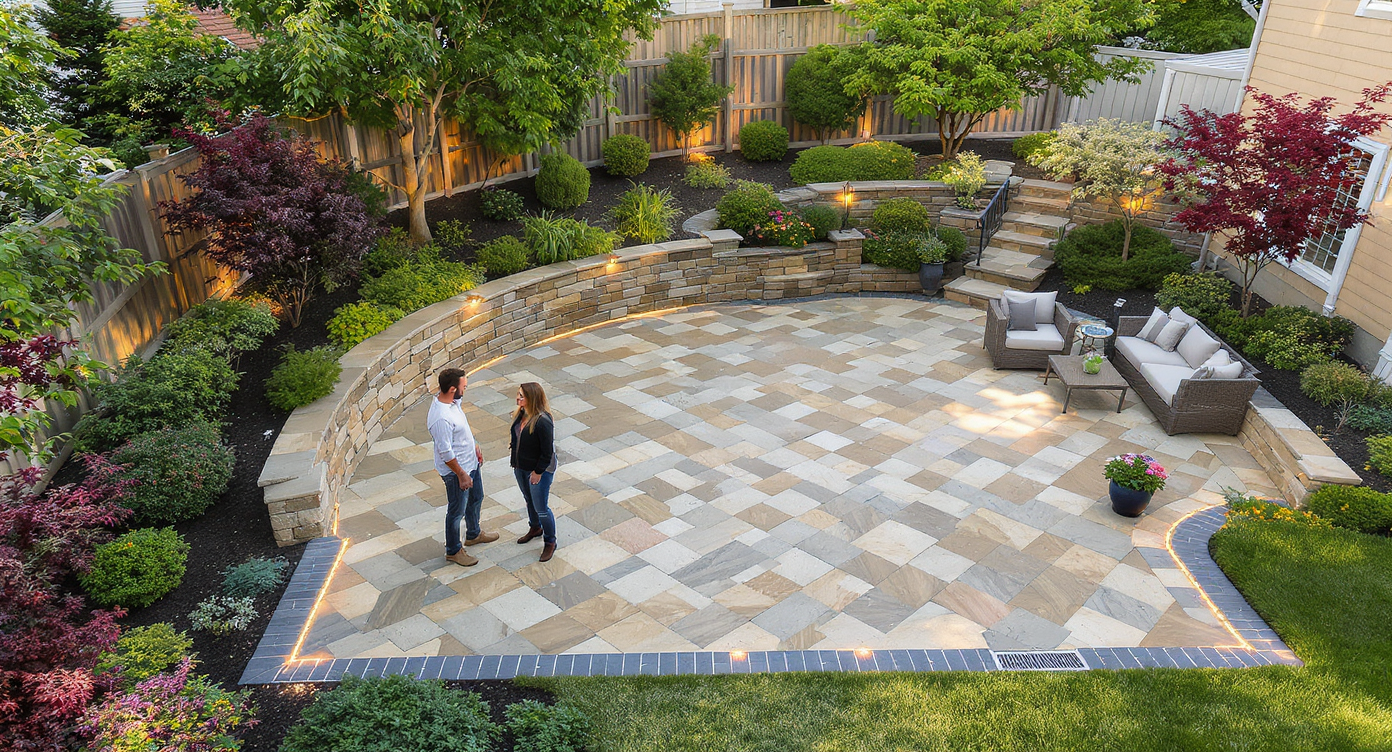




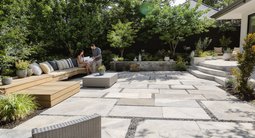


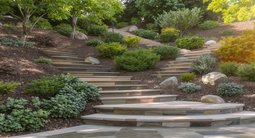
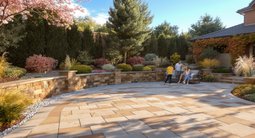


.png)